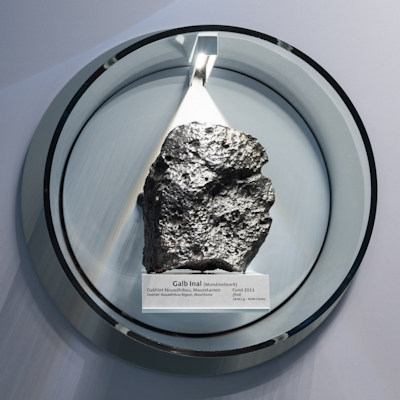
A new addition to the Natural History Museum only arrived after a long journey of almost 400,000km: a chunk of moon rock that fell to earth as a lunar meteorite.
- The piece from the Galb Inal meteorite weighs close to 2kg
- On display in the world-class meteorite section of the museum (to be fair, you’d not expect it in the gallery of stuffed mammals)
- Acquired through a kind donation in the will of Hatice Skarits
- See also:
The Galb Inal meteorite

(Photo © NHM Wien, C. Rittmannsperger)
Pity the poor lunar meteorite, Galb Inal. One moment you’re a bit of moon rock minding your own business and enjoying the (drab) view. The next, some kind of impact event sends you flying off into space.
Moments later you’re hurtling toward earth to find yourself dumped unceremoniously in the Mauritanian countryside.
The meteorite split into two on impact, with one half now residing in the Meteorite Hall of the Natural History Museum.
At almost 2kg, this is one of the largest pieces of lunar rock on display to the public. (The museum has another eleven in its possession.)
Incidentally, the other half of the Galb Inal suffered a less wholesome fate. It was cut into slices, which are now mostly found in private collections.
Research reveals that the original meteorite probably weighed something between 7kg and 23kg and may have been as large as 26cm in diameter.
In terms of composition, what you see is a lunar breccia made of feldspar, with a shiny black, wind-polished surface, and containing fragments of rocks and minerals.
Much of the material burned off in the atmosphere, of course, leaving just over 4kg to be found by nomads in 2011.
Given the rarity of the lunar rock (with only a few hundred similar examples on earth known to scientists), the museum has the generosity of Hatice Skarits (1930-2016) to thank for the acquisition: she made provision for part of her inheritance to be used for the purchase of a meteorite for the museum’s collection.
How to get to the meteorite
Find your way to the Natural History Museum using the tips in the main article.
Once inside, head right to find the geology section. The Meteorite gallery (Hall 5) within contains hundreds of rarities and wonders from space, including the giant Knyahinya meteorite weighing almost 300kg and the Hraschina meteorite that started the collection back in the 18th century.
And for some other special exhibits in the museum, albeit rather more terrestrial, keep going on this floor to eventually reach the exquisite bouquet of gems and the paleolithic Venus of Willendorf.
Address: Burgring 7, 1010 Vienna